Nostalgia: A Cypress College Photo Gallery
by Cari Jorgensen on July 19, 2018
-
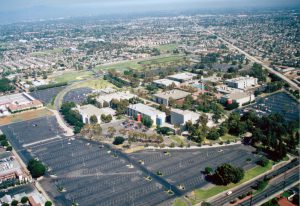
-
This undated aerial photo, believed to be from the early 1990s or late 1980s, shows the Cypress College campus prior to construction of the Student Center and the Library/Learning Resource Center. The piazza runs through the middle of the campus (notice the brick area around the campanile) and the bookstore is in temporary buildings where the L/LRC stands today.
-
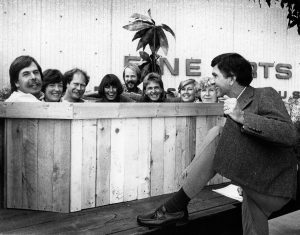
-
This 1980s photo shows the Fine Arts Division employees in a hot tub (we’re guessing it’s a home-made hot tub considering the handwriting on the unfinished wood) that was placed onto a flat-bed truck as part of the then-annual Walk/Jogathon. Apparently, the Fine Arts staff weren’t big exercise fans, electing for a relaxing ride instead.
-
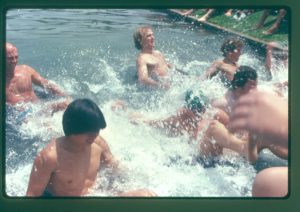
-
The college first began holding “Duck Pond Races” in the 1970s as a way to exhibit school spirit. The annual races continued for more than two decades, into the early 2000s, before a new wave of construction brought an end to the streak.
-
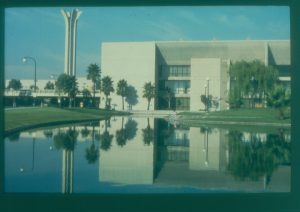
-
This early view of the campus pond, believed to be in the 1970s, shows a new looking Cypress College Complex (then the Library/Administration Building), Lakeshore Drive running under the piazza, and a section of piazza that was removed to allow construction of the Student Center in the mid-1990s.
-
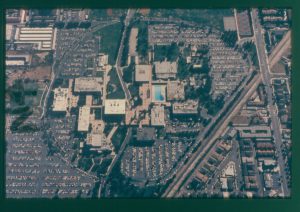
-
Here’s a full aerial view of the campus in the late 1970s or early 1980s. In this photograph, you can see the full piazza as it was originally designed (note the red brick pattern through the middle of campus), including a ramp that facilitated use of the piazza by delivery and work vehicles (look between the two gymnasiums). There are also outdoor racquetball and basketball courts (at the center top of photo). Temporary buildings that formed the original “instant campus” are visible adjacent to Lot 4.
-
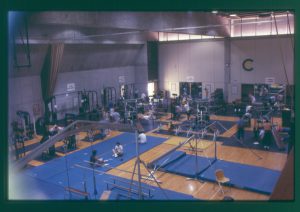
-
The “light leak” at the left edges of the photo indicate that it’s from the 1970s. It shows gymnastics equipment in what is now the fitness lab, located in Gym I. In those days, Cypress College competed in Gymnastics as part of its renowned intercollegiate athletics program.
-
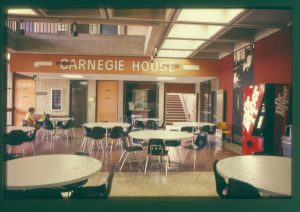
-
This 1980s photograph shows the Carnegie House — the common gathering area in the Business Building. At the college’s inception, each building had its own food-service area (note the “snacks” sign on the door at the middle left) and student government representing students in that discipline.
-
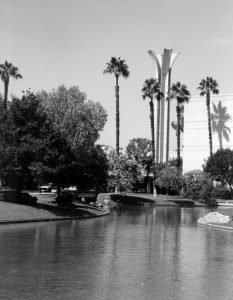
-
While the trees are more mature, the pond area, circa 2000, doesn’t look much different than it did in the 1980s and 1990s. Although the road was closed because seismic retrofitting of the piazza required supports that blocked the path, the roadway itself is still visible.
-
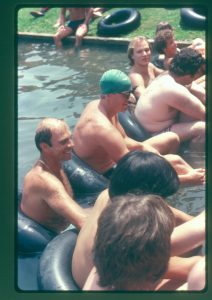
-
The college first began holding “Duck Pond Races” in the 1970s as a way to exhibit school spirit. The annual races continued for more than two decades, into the early 2000s, before a new wave of construction brought an end to the streak.
-
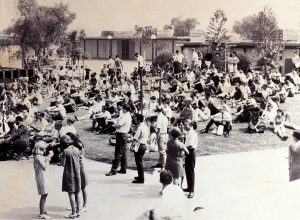
-
Opening day in September 1966 included a campus gathering in the quad area. This photograph shows the original campus — which consisted exclusively of portable buildings — adjacent to Lot 4. The college opened 74 days after the North Orange County Community College District closed escrow on the property.
-
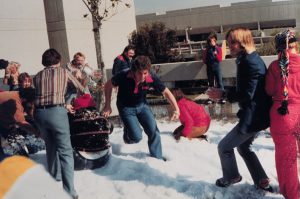
-
It’s a snow day! Students (and it would appear some employees) engage in a snowball fight on the piazza outside the Fine Arts Building. The glory of 1970s apparel is on full display. Also of note are the cement railings that line the piazza. These railings were removed in the mid-2000s, when they were replaced by the blue, metal railings.
-
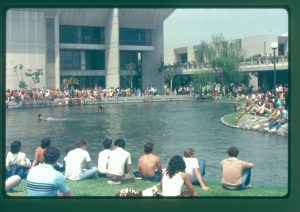
-
The college first began holding “Duck Pond Races” in the 1970s as a way to exhibit school spirit. The annual races continued for more than two decades, into the early 2000s, before a new wave of construction brought an end to the streak. This photograph shows a section of the piazza, known as “the pier,” running from the Complex building past SEM.
-
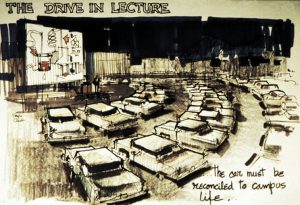
-
An original architectural drawing illustrates a prevailing mindset that “car culture” was taking hold in Southern California. The caption “the car must be reconciled to campus life” came to fruition with the piazza, but the drive-in lecture didn’t make it off the drawing board.
-
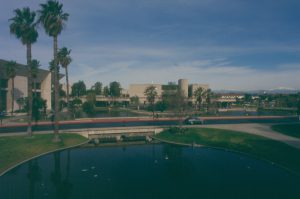
-
You wouldn’t know it today, but cars used to be able to drive through the middle of campus, as was the case in this 1980s photo. The road is no longer there — nor is the section of the piazza, known as the pier — that ran in front of the Science, Engineering, and Math Building. The original campus architects designed the college so that students in cars could travel on the ground level and pedestrians could use the upper level (though some are seen here).
-
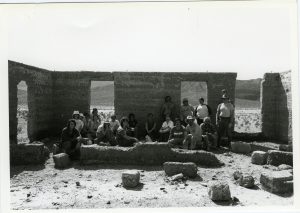
-
Cypress College students are seen participating in a geology field trip in this undated photograph. These field trips remain a vibrant part of the college’s curriculum today.
-
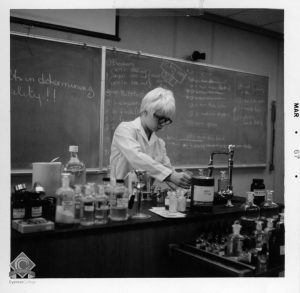
-
This photograph of a student in a science lab was taken during the first academic year and processed at the photo lab in March 1967 (photographs used to include this detail back in the day).
-
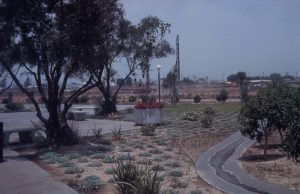
-
A garden marks what was then the “edge” of campus circa 1970. Closer examination shows work on the Gym, where two pieces of heavy equipment are driving piles to support the future building, and framing for the pond (center). Partially obscured by the tree is the sign at KFC on Valley View, a big red chicken bucket, which stands to this day.
-
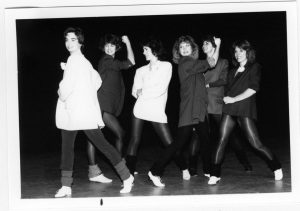
-
The ‘80s featured a unique clothing style — leg warmers, over-sized tops, and lots of tight leggings. Based on the shoes, this was taken either in a tap or jazz class.
-
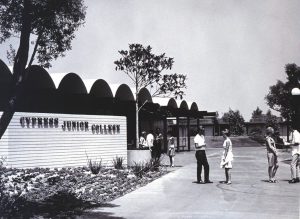
-
This 1966 photograph shows the original campus — which consisted exclusively of portable buildings — adjacent to Lot 4. The college opened 74 days after the North Orange County Community College District closed escrow on the property.
-

-
Students participate in the 30th commencement in May 1996. The processional started on the piazza and continued down the ramp onto the east lawn, next to Gym II (the building seen in the background). The large jacaranda trees provided a beautiful purple accent to the field back when graduation was held in that area. The graduation ceremony was moved to Gateway Plaza in 2009, following completion of the Student Center and the Complex renovation.
-
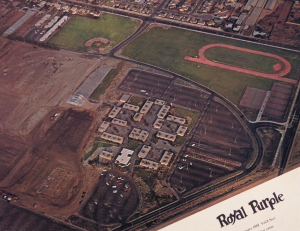
-
An aerial view shows the original campus — which was entirely portable buildings and exterior athletic facilities. The photograph appeared on the cover of the “Royal Purple” (the original student publication) in January 1968. Prep work is seen underway on the Business and Tech Ed II buildings.
-
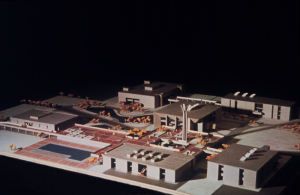
-
An architectural model provides a good overview of the piazza, pond, and campanile. Subsequent changes to building placement make this photo a little disorienting.
-
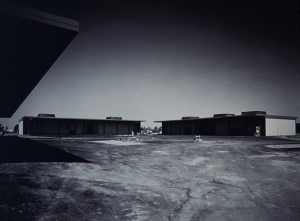
-
Shot during the summer of 1966, this photograph shows work to prepare Cypress College for its first opening day. The college opened with classes held in temporary buildings just 74 days after escrow closed on the property, which used to be (primarily) a dairy farm. “Newsweek” magazine called it “the instant campus.”
-
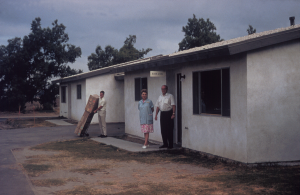
-
When Cypress College acquired the property to build a campus, a few bungalows resided on the northeast corner (across the street from the fire station on Holder Street). Administrative offices and the bookstore were housed in these former houses. In fact, most of the college’s original employees were interviewed in what had been living rooms.
-
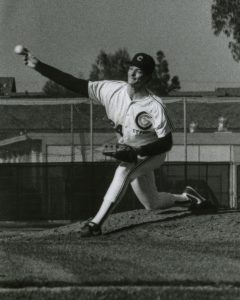
-
Cypress College’s baseball team became a powerhouse in the 1980s with the arrival of Coach Scott Pickler. This undated photograph from the era shows one of the team’s pitchers in action.
-
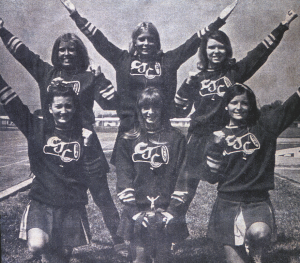
-
Cypress College’s cheer squad, circa 1970, is seen in a newspaper photograph. Notice the “CJC” on the uniforms, taking us back to a time when “junior” was a common designation for what are now almost universally known as community colleges.
-
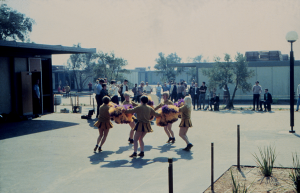
-
Cypress College’s first-ever opening day — September 12, 1966 — featured festivities that included the campus band and cheerleaders.
-
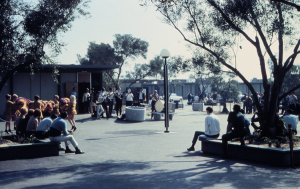
-
Cypress College’s first-ever opening day — September 12, 1966 — featured festivities that included the campus band and cheerleaders.
-
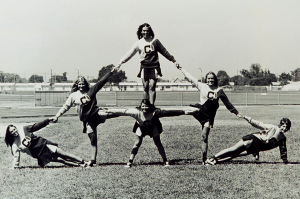
-
Cypress College cheerleaders form a pyramid on the campus track. Circa 1966.
-
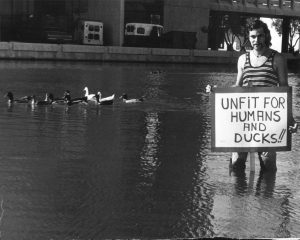
-
Steve Cifelli, one of the student leaders in the 1970s, stages a protest in the campus pond. Things worked out as Cifelli maintained a long relationship with the college as an alumnus and donor.
-
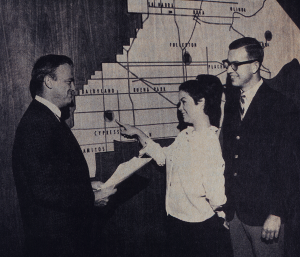
-
In December 1966, the official map of the North Orange County Community College District was updated to include Cypress College. Note the map contains familiar city names — Cypress, Buena Park, Los Alamitos, La Habra, Fullerton, Brea, and Placentia — and a couple that have since disappeared: Dairyland and Olinda.
-
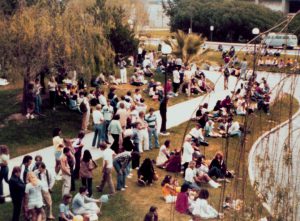
-
Students gather at the pond in the late 1970s or early 1980s. Gym I and the racquetball courts are visible in the background, as is Lakeshore Drive, which used to run through campus from Valley View to Holder.
-
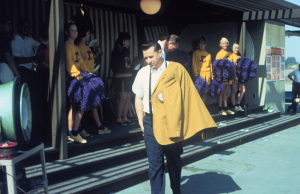
-
Cypress College’s first president, Dan Walker, is seen walking with a gold sport coat draped over his shoulders. The campus colors back in the day were officially “old gold” and “royal purple” (note the pom-poms). This appears to be a pep rally at the Olive Tree Theater in 1966.
-
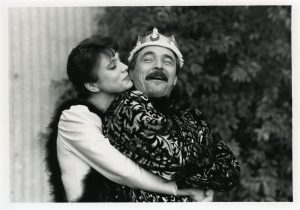
-
Cypress College has a rich history of musical theater. The first campus theater opened in the 1960s in temporary buildings, prior to the opening of the 580-seat Campus Theater, which serves the campus today.
-
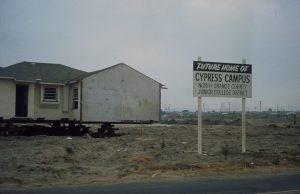
-
Cypress College opened a stunning 74 days after escrow closed on the purchase of the property. One of the first changes was the installation of signs announcing the new campus. This sign now hangs on the third floor of the Cypress College Complex.
-
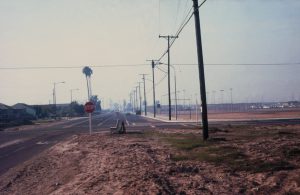
-
This is the intersection of Holder Street (running left to right in the photograph) and Orange Avenue (running bottom to top) in the late 1960s. Visible on campus are the tennis courts and the temporary buildings that formed the initial Cypress College campus.
-
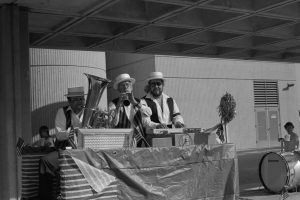
-
Strike up the band! This undated photo appears to be taken around the American bicentennial celebration and the band is reminiscent to those at our neighbor Disneyland. We’re betting only old-timers know where this photo was taken. It’s in front of the Science/Engineering/Math Building facing the pond. The section of piazza covering the band was removed in the early 2000s.
-
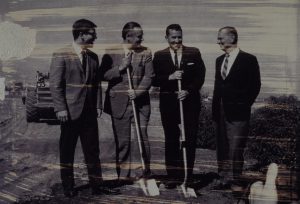
-
Dignitaries participate in the groundbreaking ceremony for Cypress College in 1966. The campus went from dairy farm to operating college in just 74 days.
-
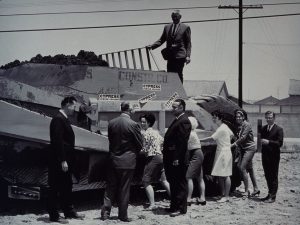
-
The first Cypress College employees got to work quickly, converting the dairy farm to a college campus in just 74 days between the close of escrow on the property and the start of classes in 1966.
-
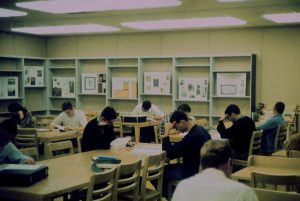
-
When Cypress College opened in 1966, everything was housed in modular — we called them “temporary” even though the last of them were removed 40-plus years later — buildings. This is the library. It featured shelves for books and rows of tables and chairs. Personal computers and WiFi were quite a ways off back then.
-
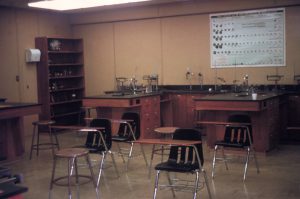
-
One of the first labs on campus appears to be a multi-use room with space for lecture and experimentation in the same room. Today, labs are generally separated from lecture space for efficiency. Cypress College is expanding both lecture and lab capacity with construction of a new Science/Engineering/Math Building.
-
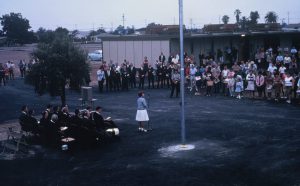
-
Legend has it that college officials worried that the cement holding the flagpole in place wasn’t sufficiently set on the opening day of the campus. It held firm and the September 12, 1966 ceremony was a success. Today, this pole resides at the NOCE building on campus, near Lot #4. The railroad tracks are visible in the background of the photograph.
-
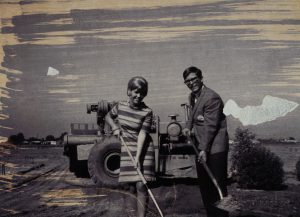
-
This photograph, from the late 1960s depicts a groundbreaking ceremony. Already visible in the ground are the tops of piles used to form the foundation of a building.
-
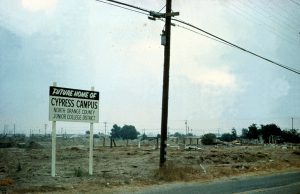
-
This photograph shows one of the signs announcing the start of construction of the Cypress College campus in 1966. Visible in the background is a giant movie screen from the Lincoln Drive-In, which was located at the corner of Lincoln Avenue and Holder Street until it was demolished in 1996.
-
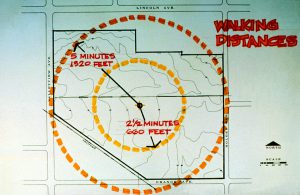
-
Pedestrians and vehicles figured prominently into the design of Cypress College. The upper-level pedestrian walkway, known as the piazza, was constructed to help students get to class quickly. Walking times were calculated as taking 5 minutes from the edge of campus to the center, and just 2.5 from any building to another. Cars no longer drive through the middle of campus (a road used to run past the pond) and the piazza has been re-configured.
-
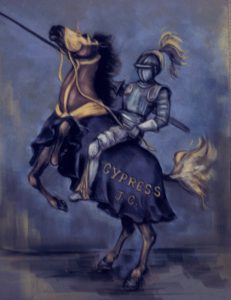
-
Incoming students voted in July 1966, with 200 ballots were returned, to select school colors and a mascot. By an overwhelming vote the students selected Royal Purple and Old Gold as the school colors — but “Chargers” only edged “Centurions” by three votes as the college mascot. The colors were eventually changed in the late 1980s.
-
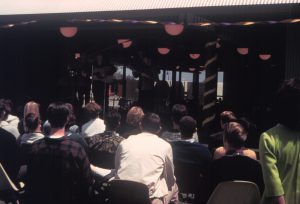
-
Performances and gatherings were a staple of early campus life — first in the temporary buildings and later adjacent to the pond.
-
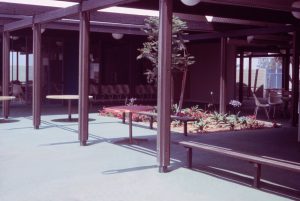
-
The original dining and gathering area was quite a bit understated. The chairs hint at a very different design style popular in the late 1960s and early 1970s. One thing that hasn’t changed much is the beautiful landscaping, which has been a constant at Cypress College since the campus opened.
-
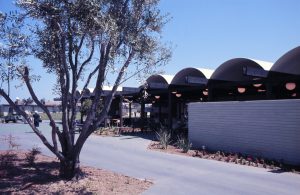
-
This photograph shows a portion of the original Cypress College campus, which was built using modular structures near what is Lot #4 today. The decision allowed Cypress College to open just 74 days after escrow closed on the property, which used to be a dairy farm.
-
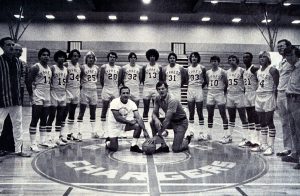
-
This undated photograph shows the men’s basketball team, coached by the late Don Johnson — for whom the court is now named. Coach Johnson retired as the all-time wins leader in California Community College basketball history. He is pictured at center court in the dress shirt and slacks.
-
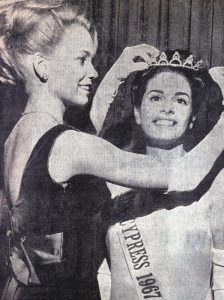
-
This photograph shows the crowning of Miss Cypress 1967.
-
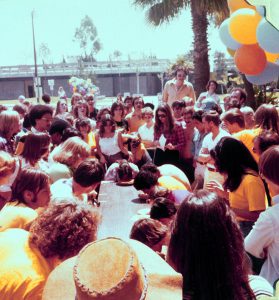
-
Another lost tradition at Cypress College was the annual pie-eating contest. The event was hosted by Student Activities. This photograph appears to be from the 1980 and it appears the contestants are all students. Later competitors in the event included members of the classified support staff.
-
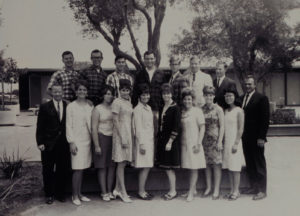
-
This group of employees and student leaders helped get Cypress College started. They include Dan Walker, Cypress College’s first president, seen at the lower left of the photo.
-
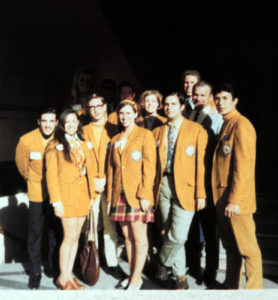
-
“The Gold Coats” are famous among Cypress College’s long-time employees. The coats were worn by people, including both employees and student ambassadors, who were off campus speaking on behalf of the college.
-
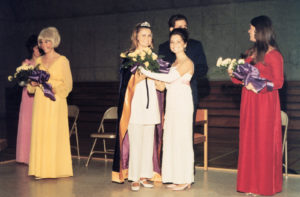
-
Back in the day, Cypress College used to celebrate homecoming. We don’t know the date of this image, but the school colors — old gold and royal purple are on full display.
-
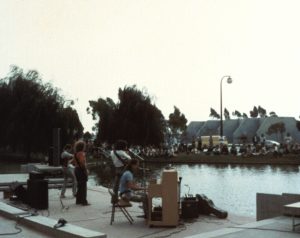
-
Concerts used to be a regular feature of student life. Here you see the band set on the stage overlooking the pond. In the background are the since-demolished racketball courts and a van that appears to be a good fit for Scooby Doo.
-
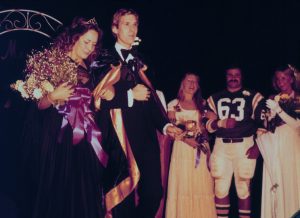
-
Back in the day (this undated photo appears to be from the 1970s), Cypress College used to both have a football team (as illustrated by the player wearing #63) and a homecoming ceremony.
-
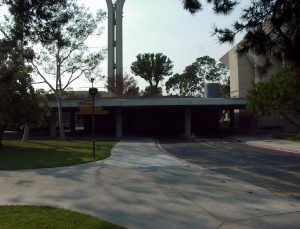
-
The shadows slightly obscure the fact that a road used to run right through the middle of campus. The campanile gives away the location to a large extent. On the right the what’s now called the Cypress College Complex, the pond is to the right, and the piazza seen at the center of the photo has been replaced by the Student Center.
-
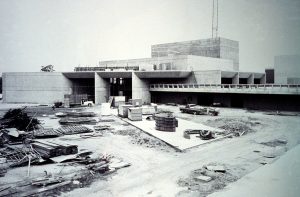
-
Cypress College’s Theater and Theater Arts buildings, along with what is now Gateway Plaza, are seen under construction in the early 1970s or very late 1960s.
-
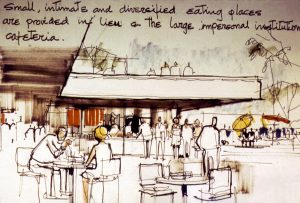
-
This rendering illustrates the idea for “the house concept” in which each building had gathering spaces, it’s own Associated Students representation, and its own food services! Although the food and A.S. are no longer there, today, you can see this remains most prominently in the Business, SEM, and TE-1 buildings.
-
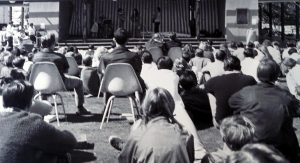
-
The college’s first theater was known as the “Olive Tree” and it was located among the collection of temporary buildings that formed the original campus, just north of where Lot #4 is today.
-
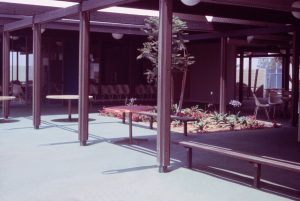
-
When Cypress College opened just 74 days after its formation (yeah, that seemed an incredible achievement right up until we transitions instruction to all remote in under a week), it was located in the area where NOCE now resides. This was an outdoor dining area.
-
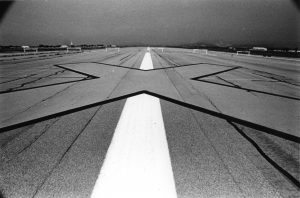
-
The large X is an indication that the runway is closed. This photograph (circa 2002) was produced as part of a project documenting the decommissioning and closure of Marine Corps Air Station, El Toro by the late Professor Jerry Burchfield and retired Professor Rob Johnson.
-
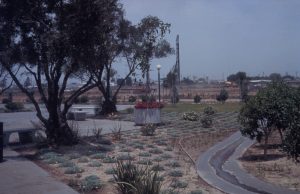
-
These plants ring the edge of the original campus footprint (what is now NOCE, near Lot #4).The buildings near the cement mixer served as the initial administration offices and bookstore (near Holder and Lincoln), the pile driver at the center is near the pond, and some of the surrounding community is visible — including what appears to the KFC sign between tree branches (the splash of red).
-
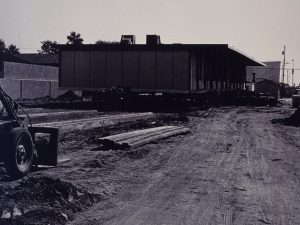
-
A modular building is delivered to campus circa 1967 near the northeast end of campus between the baseball field and the apartments. Visible in the background is one of the large movie screens from the adjacent drive-in theater, which is where the College Park homes are now located.
-
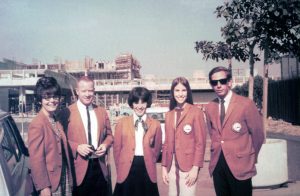
-
Campus members who represented the college in the community wore “old gold” sports coats in their official capacity. Also visible in this photo is the Campus Theater (what is now the Art Gallery is at the center of the photo) and piazza construction and a sliver of the Cypress College Complex (right).
-
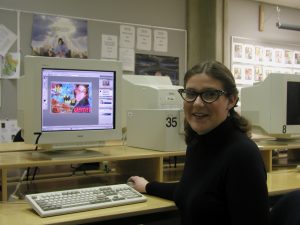
-
An art student demonstrates her work on what was then (circa 2000) a new computer-based design lab. Check out how huge — as in physical footprint, not screen real estate — those monitors were back in the day.
Related



































































